
Rescuing the “Raichō”: Hope for Japan’s Iconic Rock Ptarmigan
Society Science Culture Environment- English
- 日本語
- 简体字
- 繁體字
- Français
- Español
- العربية
- Русский
The raichō, or Japanese rock ptarmigan (Lagopus muta japonica), is a beloved and iconic inhabitant of the rugged Japanese Alps in central Honshū. Traditionally associated with the deities inhabiting those mountains, this remarkably approachable terrestrial bird has been largely protected from human predation by cultural norms as well as Japanese law. Nonetheless, a variety of environmental threats, including global warming, have decimated the raichō’s numbers over the past few decades. Today, a coordinated initiative by scientists and zoos, supported by the Ministry of the Environment, is making tangible progress toward the recovery of the species.
History of a Natural Monument
The rock ptarmigan is widely distributed across the arctic and subarctic regions of Eurasia and North America, but the Japanese raichō’s alpine habitat represents the southern limit of the species’ global range. Found only at high altitudes in a mountainous area straddling parts of Nagano, Toyama, Gifu, and Niigata Prefectures, the raichō has survived with the help of protectively colored plumage, which turns snow-white in the winter (although males display a distinctive red eyebrow). If spotted, however, it can often be approached quite closely, as it exhibits almost no fear of humans.

A male raichō, or Japanese rock ptarmigan, in its distinctive winter plumage. (March 2017, Mount Norikura)
Some have attributed the raichō’s unwary behavior to the revered status it has enjoyed since ancient times. In a country where mountain worship thrived for centuries, the birds were long revered as incarnations or messengers of the mountain kami. During the Edo period (1603–1868), images of the raichō, whose name directly translates as “thunder bird,” were painted on talismans and wooden votive tablets (ema) in the belief that they warded off lightning strikes and fires.
The first recorded efforts to protect and breed the raichō also date back to premodern times. More recently, in the early eighteenth century, the Kaga domain (present-day Toyama and Ishikawa Prefectures) ordered surveys of the ptarmigan populations on the mountains Hakusan and Tateyama and issued a proclamation stating that the bird was to be protected. The eighth Tokugawa shōgun, Yoshimune (ruled 1716–51), had a number of birds captured on Mount Norikura in the Hida Mountains (also known as the Northern Alps), where they were said to be abundant, and attempted to breed them. That early captive-breeding program ended in failure, as did several subsequent efforts, according to contemporary records.
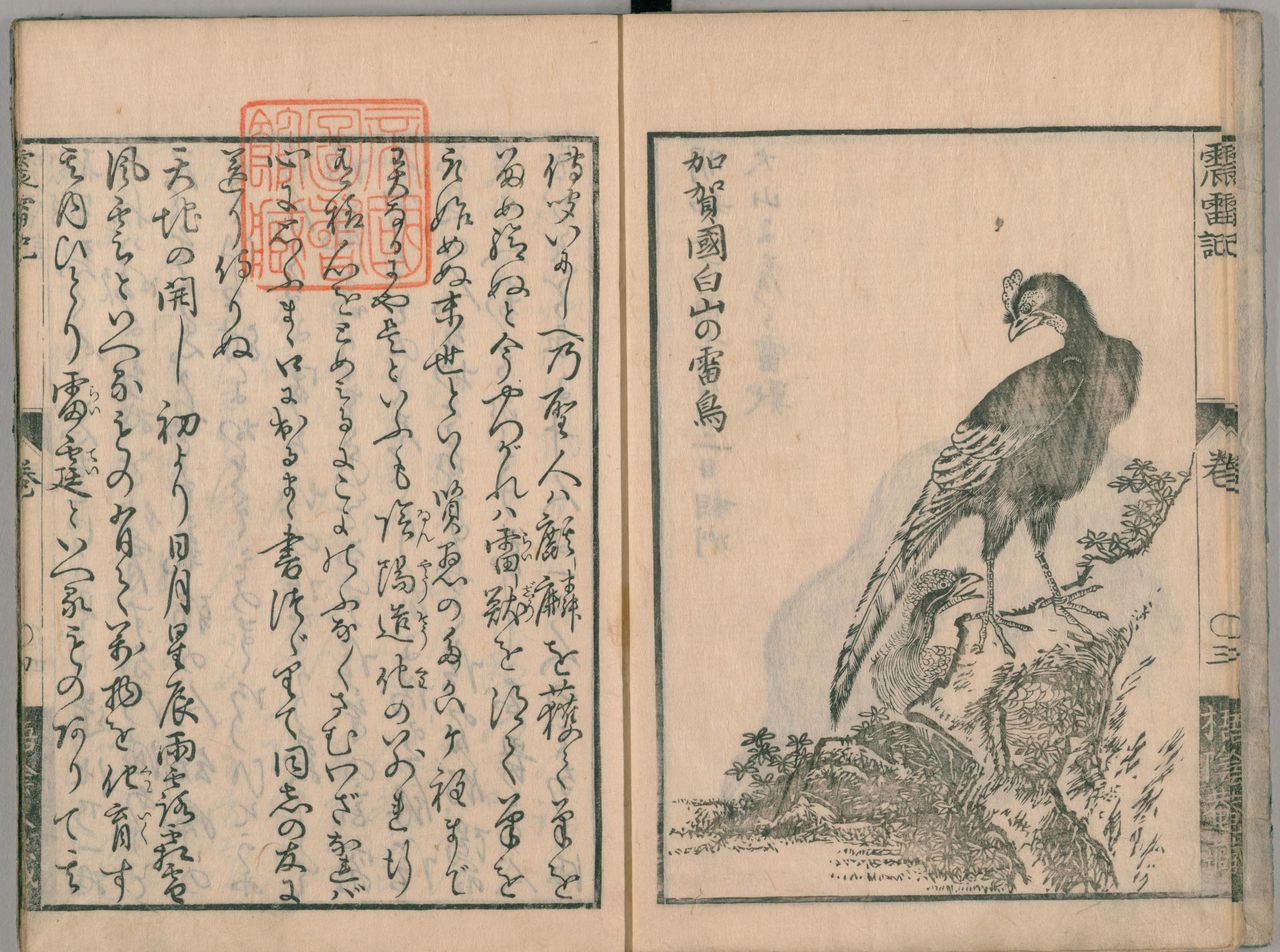
The 1767 record Shinraiki describes early attempts to breed the raichō. (National Diet Library)
Prior to modern times, when towering peaks like Hakusan, Tateyama, and Norikura were viewed with spiritual awe, few human beings other than religious ascetics regularly frequented the raichō’s rarefied habitat. However, as Western ideas and practices flourished following the 1868 Meiji Restoration, the mountains lost much of their sacred mystique. Mountaineering became more common, and the raichō were even hunted until the practice was expressly prohibited in 1910.
In 1955, the Japanese government designated the raichō a Special Natural Monument under the Law for the Protection of Cultural Properties. Nonetheless, its numbers have declined substantially over the last few decades, falling from an estimated 3,000 in the 1980s to less than 2,000 today. Among the contributing factors is climate change, which has permitted other animals to move from lower altitudes into the birds’ habitat. Newly arrived predators, including foxes, weasels, crows, and kestrels, present a direct threat to the birds, while grazing by deer and wild boar can strip mountain slopes of the vegetation on which the ptarmigan depend for food and cover.
Sheltering Vulnerable Chicks
In 2012, the Ministry of the Environment officially designated the raichō an endangered species and launched a major conservation and recovery program. Field studies and projects carried out by Professor Nakamura Hiroshi of Shinshū University and his research team, including ornithologist Kobayashi Atsushi, have been critical to this initiative.
“Professor Nakamura and I conducted surveys of the birds living on mountains higher than 3,000 meters to gauge their survival rate at each stage, from egg to adulthood, and determine how best to target our protection efforts,” explains Kobayashi. “These studies laid the foundations for Dr Nakamura’s cage-protection project, which began in 2015.”
According to Kobayashi, the female raichō typically lays six or seven eggs in a nest built on the ground. Under typical conditions, only one chick from such a clutch survives to adulthood. The eggs hatch during the rainy season, and the young chicks, which follow their mother out of the nest soon after they hatch, are particularly vulnerable to harsh weather and predation during their first month. Those that do survive, however, mature quickly and are ready to breed the following spring. Based on these observations, Nakayama and his team decided to focus on protecting the chicks during the critical first four or five weeks.
“The Japanese raichō have no fear of humans, so we’re able to lure them into cages over a period of one or two days,” Kobayashi explains. “We let the brood wander and forage freely during the day, but at night we shelter it in a cage, which is provided with fresh food.” The work begins when the chicks hatch, near the end of June, and continues until early August.
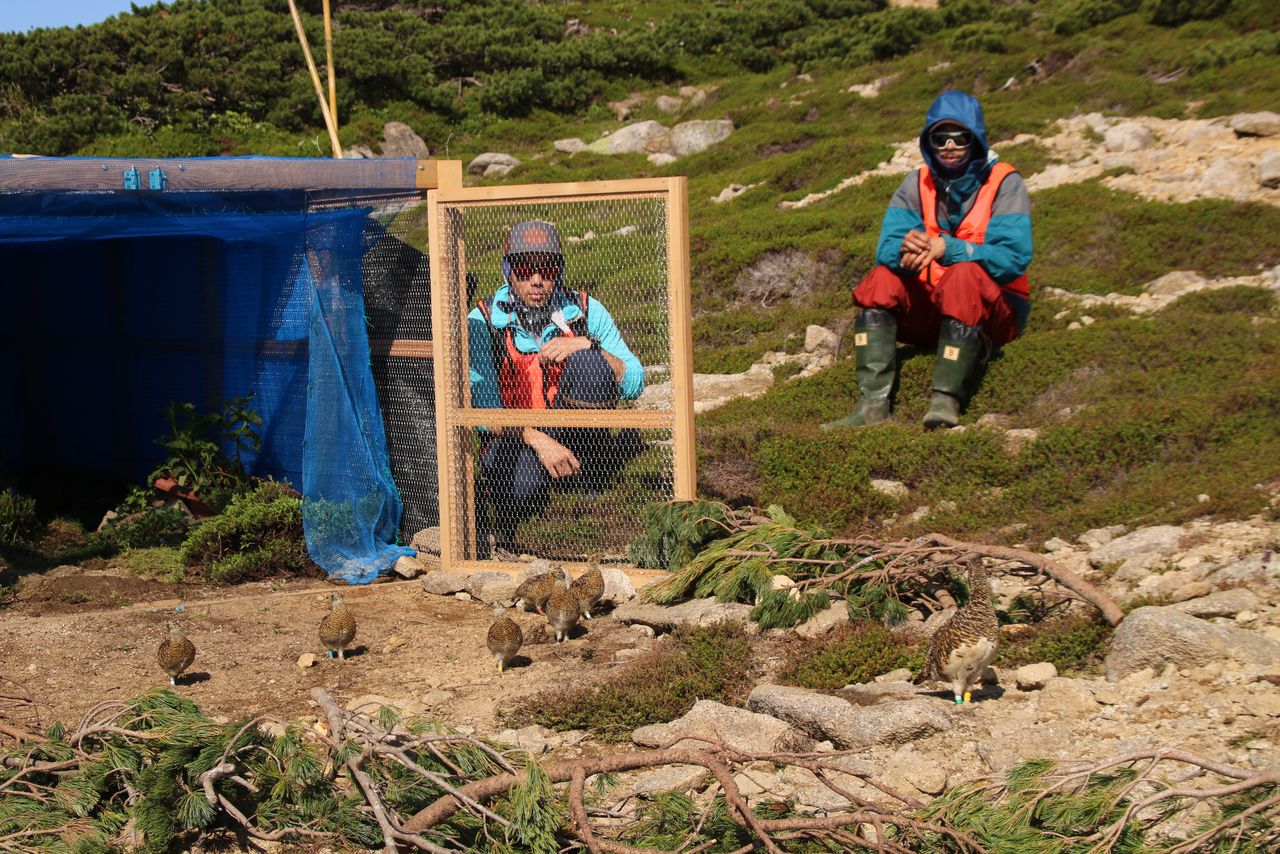
A mother raichō and her brood leave the safety of their temporary cage to forage. (August 2020, Central Alps)
Restoring the Raichō to the Central Alps
An overlapping project aims to reestablish a breeding population in the Kiso Mountains, also known as the Central Alps.
In July 2018, a mountain climber discovered a solitary female raichō on Mount Kiso-Komagatake (Nagano Prefecture) in the Central Alps, where the birds are believed to have disappeared sometime in the late 1960s. A DNA analysis determined that the bird was most likely a “vagrant” who had flown there from Mount Norikura (straddling Nagano and Gifu Prefectures), which has a fairly stable raichō population. This discovery inspired Operation Resurrection, which aims to establish a breeding population of 100 in the Central Alps by 2025.
The project began in 2019, when researchers replaced unfertilized eggs laid by the vagrant female with fertilized eggs laid by raichō nesting on Mount Norikura. The next year, the same process was carried out using fertilized eggs from females in zoo breeding programs. In both cases the transferred eggs hatched successfully, but unfortunately all of the chicks fell victim to harsh weather and predators.
All was not lost, however. In August 2020, three raichō families, including 16 healthy chicks, were transferred directly from Mount Norikura to the Central Alps, with heartening results. In July 2021, researchers spotted 10 broods in the Central Alps, including one produced by the vagrant female. Five of the families were placed under temporary cage protection, and two of those were later transferred to zoos (Nasu Animal Kingdom in Tochigi Prefecture and Nagano Chausuyama Zoo in Nagano Prefecture) to be bred in captivity. Kobayashi is hopeful that the captive birds’ offspring can be returned to the wild to help colonize the Central Alps.

A clutch of eggs and the three-day-old raichō chicks that hatched from them in June 2021 attest to the early success of Operation Resurrection in the Central Alps. The mother is the lone female who strayed into the area in 2018.
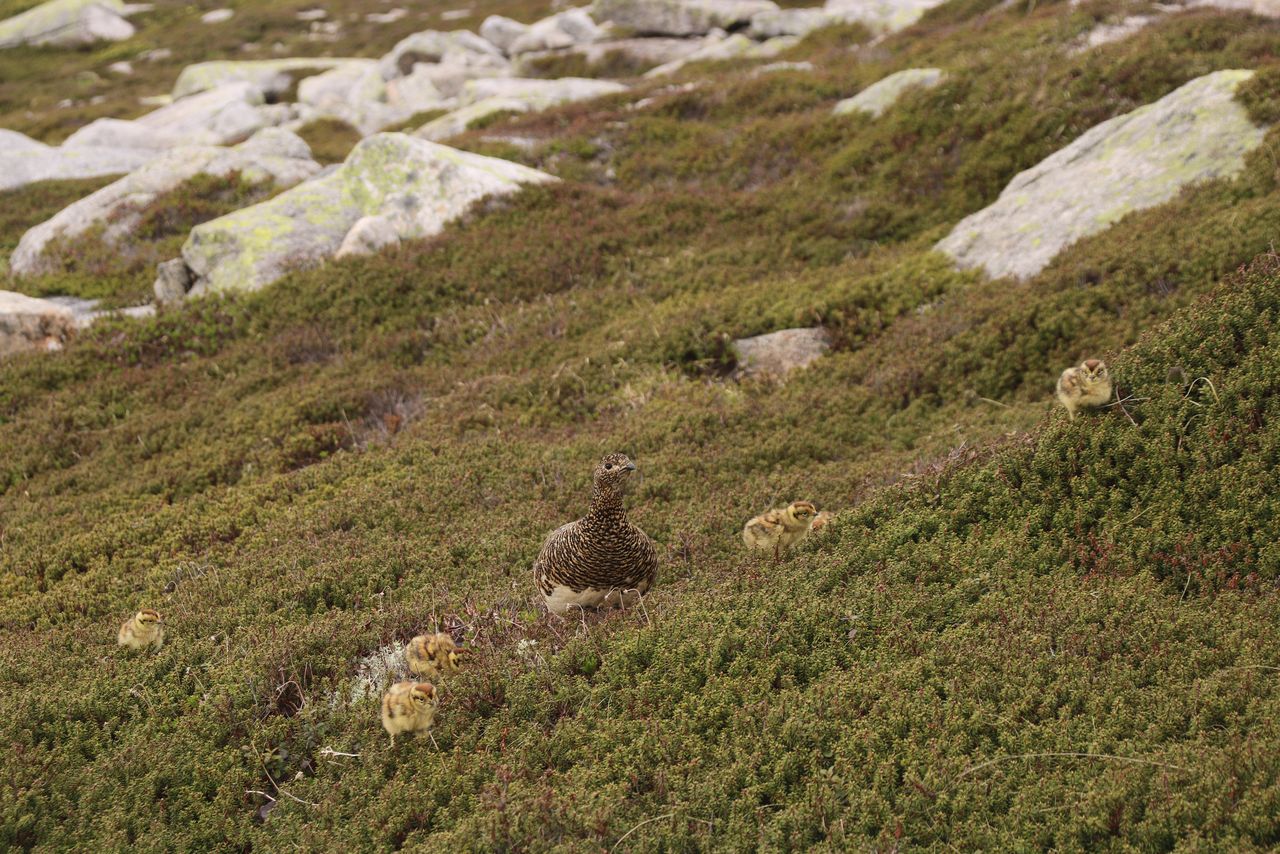
A mother raichō walks out with her chicks in Japan’s Central Alps in July 2021.
Zoos to the Rescue
Working in tandem with these in-situ conservation efforts, which support the animals in their natural habitat, is an ex-situ program launched in 2015 by the Japanese Association of Zoos and Aquariums and affiliated zoos. Ex-situ conservation is aimed at ensuring the survival of species through captive breeding and intensive scientific study. The role of Japanese zoos in the conservation of species was made explicit in the 2018 revision of the Act on Conservation of Endangered Species of Wild Fauna and Flora.
An important contributor to this ex-situ conservation program is Associate Professor Kusuda Satoshi of Gifu University, who has analyzed the effect of light, temperature, and other factors on the raichō’s hormone levels in order to optimize captive-breeding conditions.
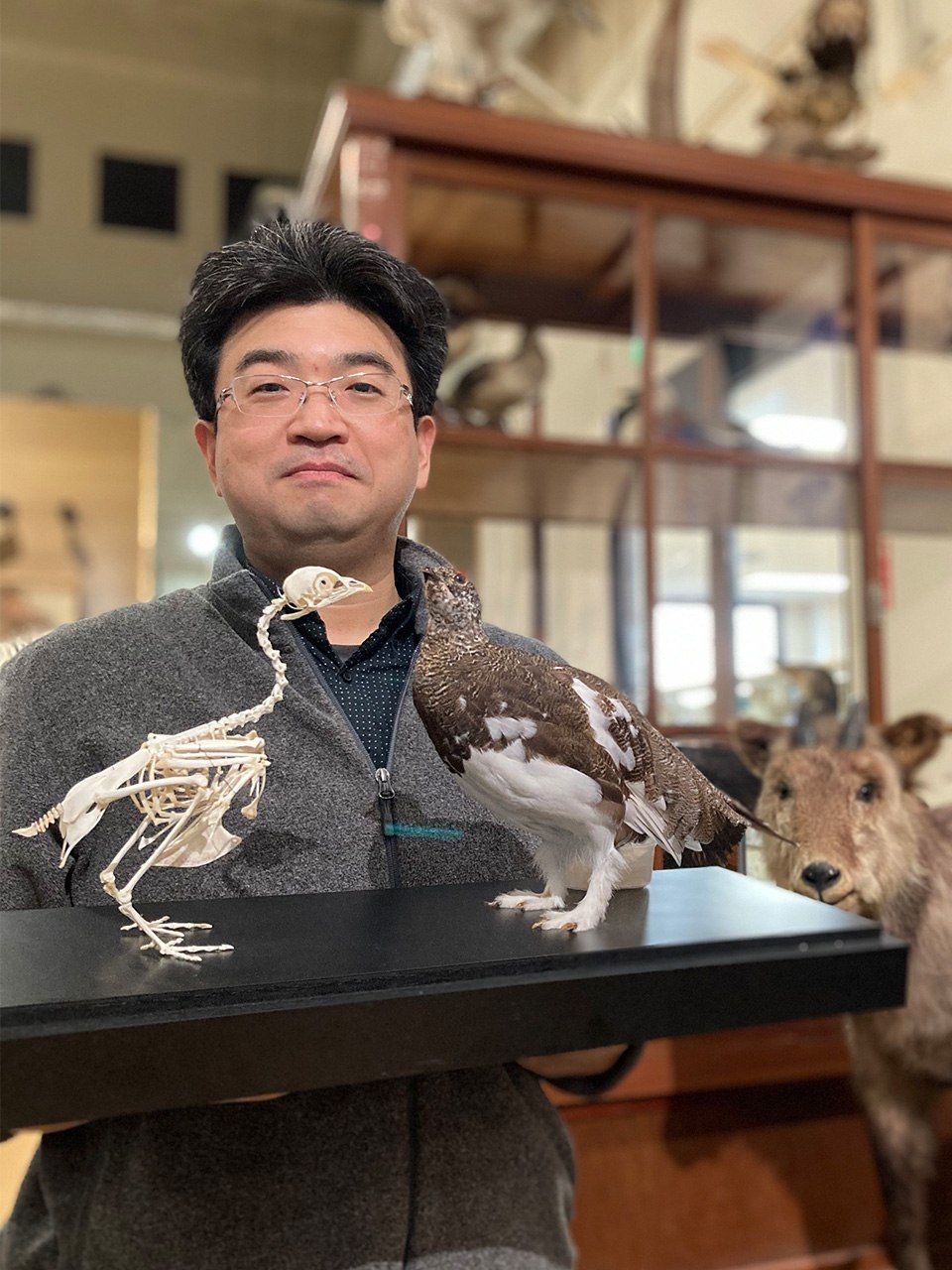
Associate Professor Kusuda Satoshi, a leader in the study of raichō reproductive physiology.
“To succeed in ex-situ conservation, one first needs to understand how an organism interacts with its natural habitat in the wild,” says Kusuda. “The breeding cycle of birds is influenced by light. Rock ptarmigan enter their breeding season as the days grow long, and the Japanese raichō is especially sensitive to changes in light exposure. For that reason, it’s important to duplicate natural light conditions as closely as possible if we want the birds to reproduce in captivity. Temperature control is a factor as well.”
With this in mind, Kusuda and his team have been analyzing changes in the hormone levels of wild raichō. “Ordinarily, one uses blood samples for this purpose, but we’ve found that it’s possible to measure hormone levels from the birds’ droppings. So, we’ve enlisted the cooperation of Dr Nakamura and Mr. Kobayashi, who collect samples in the field for us to analyze.”
The animal reproduction unit that Kusuda heads at Gifu University is involved in other ex-situ conservation projects as well, including captive breeding of the critically endangered Tsushima leopard cat at Nagoya’s Higashiyama Zoo. Two kittens were born at the facility in April 2021 and are doing well, signaling the zoo’s first success in breeding the rare felines.
“I’m thrilled that they’ve reproduced. Leopard cats in the wild generally give birth to just one or two offspring a year, so breeding them is quite a challenge. An adult raichō, on the other hand, lays six or seven eggs, so it’s possible to increase their numbers quickly, provided the eggs hatch and the caging goes well.”
Call of the Wild
Kusuda’s work takes place largely within the confines of laboratories and zoos. The first time he actually saw a raichō in the wild was in June 2013, when he accompanied Nakamura’s research team up Mount Norikura.
“Thanks to Professor Nakamura, I had the good luck to observe a female incubating her eggs while the male kept guard from an outcropping. That’s a rare sight. It’s really moving to see them in their element, in the middle of that rugged, majestic landscape.” Since then, Kusuda has made a point of taking groups of students up Mount Norikura once or twice a year to observe the raichō in the wild.
“I think when they see the raichō living in their natural habitat, it strengthens their desire to protect this important bird, and that’s bound to make a difference to their work in support of the zoos’ captive-breeding programs.”
From mid-May to October, one can take a bus up Mount Norikura to a terminal close to the 3,026-meter summit. “In May and June, you can watch the males defending their territory, and in July, you can see the chicks following their mothers about. I would love for more people to observe the raichō in the wild.”
Kusuda is keenly aware of the need to educate the public about the raichō and other endangered species, especially in Gifu Prefecture, where he conducts his research. Gifu is one of three prefectures that claim the raichō as their prefectural bird. However, unlike Toyama and Nagano, Gifu has no zoos to take part in the captive-breeding program, which currently enlists the participation of seven facilities nationwide. The resulting lack of publicity is one reason for the relatively low level of public awareness. Kusuda is working hard to convince Gifu residents of the importance of the raichō and its habitat, not only to the alpine ecosystem of the Hida Mountains in the north, but to the natural environment and culture of the prefecture as a whole.
Efforts to save Japan’s crested ibis and Oriental stork started too late, when the native populations were already on the brink of extinction. Captive breeding of those species is now underway, but it has had to rely on pairs brought in from China and Russia, respectively. Kobayashi stresses the importance of beginning captive breeding and in-situ conservation efforts before the population of raichō living in the wild dwindles even further.
“The Environment Ministry, researchers, and zoos are working together in hopes of protecting and restoring the raichō population now, before it’s too late,” says Kobayashi. “It’s not the first such collaboration, but it’s one of the few that has yielded tangible results.”
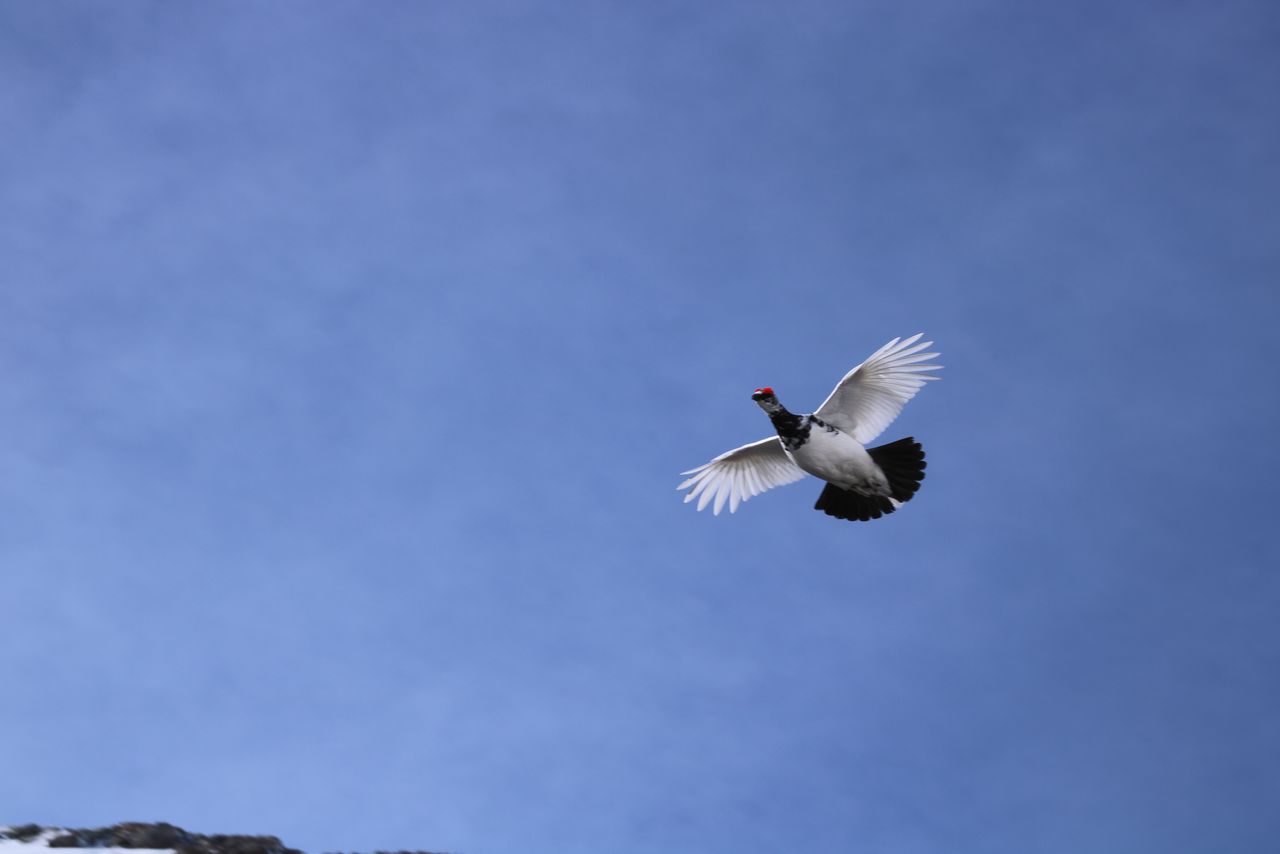
A male raichō takes flight. (May 2017, Mount Norikura)
(Originally written in Japanese by Kimie Itakura of Nippon.com. Banner photo: A male raichō surveys his territory on Mount Norikura during the 2017 breeding season. Photos courtesy Kobayashi Atsushi unless otherwise noted.)
wildlife birds environment conservation climate change Environment Ministry extinct species